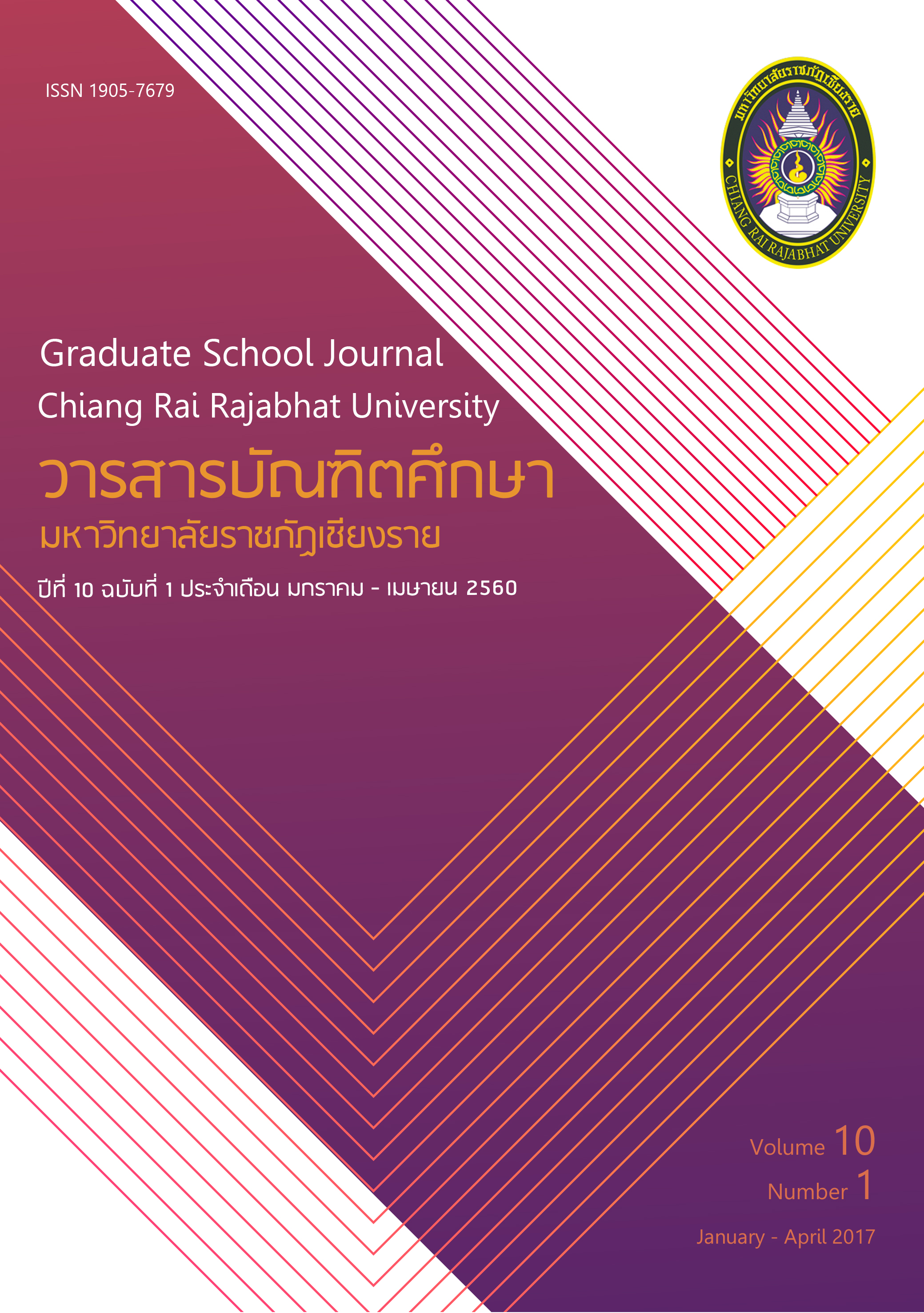On-going Strategies for Sustainable Community Forest Management Held in Phayao Province
Main Article Content
Abstract
Based on the descriptive technique, the purposes of this study aimed to explore
the current situations of community forest management held in Phayao province, as well
as to establish on-going strategies for the community forest management of Phayao province.
For data collection, district 5 person 45 respondents out of each district were selected by
the purposive sampling technique. These included formal and informal community leaders,
as well as agricultural, private and governmental representatives, and teenagers.
The fndings of the study revealed that most male married informants with their
age of 20-40 earned a diploma of secondary education level, taking charges of their
leadership. In addition to this study, the community leaders’ awareness of their effective
community forest management with its worldwide vision was needed for their community
unity and empowerment.
In terms of supportive factors affecting their participation in community forest
management in Phayao province, it was stated that community forest acts together with
national forestation policies, and national socio-economic development plans directly led
to not only their privileges for effective community forest management with emphasis on
social, economic, and environmental aspects, but also their follow-up of effective community
forest management in relations to their beliefs, local wisdoms, and pubic forest resources
mobility.
According to the analysis of SWOT, the internal factors affecting the current
situations of effective community forest management were as follows: 1) in terms of the
strength point, it was stated that the community residents’ unchangeable beliefs and
mutual awareness of their sustainable community forest management, the community
leaders’ cooperative empowerment, natural resources mobility supported for their
community’snaturalconservationandeffectivesavingsmanagement,integratedcommunity
forest management, as well as their empowerment for networking–based organizational
management were all supported; 2) in terms of the weakness point, it was stated that the
communities’ no understandings of their effective community forest management,
community forest management committee’s unclear organizational structure, no promotion for academic services, improper applications of technology, inadequate numbers of
fnancial supports, unwell-planned schemes for effective community forest management,
no collaboration with other external organizations, and no monitoring management systems
weremostlyobserved;intermsoftheopportunitypoint,itwasstatedthattheircommunity’s
interests in effective community forest management together with their opportunities in
suffcient budgeting allocation, and the other networking organizations’ promotion for
additional academic workshops and technological services were all facilitated, and 4) in
terms of their traits, it was stated that no understandings of regulations for community
forest management, as well as the local organizations’ no participation in effective
community forest management were mostly observed.
Most importantly, sustainable community forest management held in Phayao
province was divided into six major on-going strategies: the 1st on-going strategy related
to the promotion for key concepts and better understandings of their community residents’
sustainable community forest management; the 2nd on-going strategy on the development
of community residents’ sustainable community forest management; the 3rd on-going
strategy on the development of sustainable community forest management systems; the
4th on-going strategy on the development of ITC systems; the 5th on-going strategy on
the development of networking collaboration and integrated team-working, and the 6th
one related to the establishment of sustainable community forest management fund and
budgeting allocation.
Overall, the detailed suggestions for the sustainable community forest management
held in Phayao province were recommended that the provisions for the enhancement of
their revision of governmental policies for sustainable community forest management, and
their certifcation for community forest conservation and mobility be both needed.
Moreover, the involved organizations’ participatory community forest management in
networking collaborations with other organizations should be supported. Also, the
establishment of main hub handling with their sustainable community forest management,
and the local administration organizations’ community forest management schemes should
be both provided.
Article Details
บทความที่ได้รับการตีพิมพ์เป็นลิขสิทธิ์ของวารสารมหาวิทยาลัยราชภัฎเชียงราย
ข้อความที่ปรากฏในบทความแต่ละเรื่องในวารสารวิชาการเล่มนี้เป็นความคิดเห็นส่วนตัวของผู้เขียนแต่ละท่านไม่เกี่ยวข้องกับมหาวิทยาลัยราชภัฎเชียงราย และคณาจารย์ท่านอื่นๆในมหาวิทยาลัยฯ แต่อย่างใด ความรับผิดชอบองค์ประกอบทั้งหมดของบทความแต่ละเรื่องเป็นของผู้เขียนแต่ละท่าน หากมีความผิดพลาดใดๆ ผู้เขียนแต่ละท่านจะรับผิดชอบบทความของตนเองแต่ผู้เดียว
References
ฉลาดชาย รมิตานนท์. (2556). ป่าชุมชน ความหมาย ป่า และชุมชน. สืบค้นเมื่อ 6 ธันวาคม 2556,
จาก http://www.seub.or.th/index.php?option=com_content&view=category&
id=64&Itemid=79
ปาหนัน กันหาสินธุ์ และคนอื่นๆ. (2554). การพัฒนาแนวทางการจัดการทรัพยากรป่าไม้อย่างยั่งยืนของ
องค์การบริหารส่วนตำบลหนองไทร อำเภอนางรอง จังหวัดบุรีรัมย์. วารสารวนศาสตร์, 30(3),
33-42.
พรชัย ธรณธรรม และ จินตนา ทวีมา. (2554). แนวคิดการจัดการทรัพยากรธรรมชาติและสิ่งแวดล้อม.
กรุงเทพฯ: สุทธาการพิมพ์.
พระใบฎีกาวิเชียร ใจดี. (2548). การมีส่วนร่วมของชาวบ้านในการจัดการป่าชุมชน : กรณีศึกษา
ชุมชนบ้านปี้ ตำบลเวียง อำเภอเชียงคำ จังหวัดพะเยา. (วิทยานิพนธ์ศิลปศาสตรมหาบัณฑิต).
มหาวิทยาลัยราชภัฏเชียงใหม่. เชียงใหม่.
เพิ่มศักดิ์ มกราภิรมย์. (2557). ป่าชุมชน ประเด็นและสาระสำคัญ. สืบค้นเมื่อ 24 เมษายน 2557,
จาก http://ag-ebook.lib.ku.ac.th/ebooks/2011/2011-017-0007/index.html#/4/
zoomed
ไพโรจน์ คชรินทร์. (2556). ผลสำเร็จของการจัดการป่าชุมชน กรณีศึกษาป่าชุมชนบ้านปางเปา.
(วิทยานิพนธ์ศิลปศาสตรมหาบัณฑิต). มหาวิทยาลัยแม่โจ้. เชียงใหม่.
สำนักงานคณะกรรมการพัฒนาการเศรษฐกิจและสังคมแห่งชาติ. (2555). แผนพัฒนาเศรษฐกิจและ
สังคมแห่งชาติ. กรุงเทพฯ: สำนักงานฯ.
สำนักงานทรัพยากรธรรมชาติและสิ่งแวดล้อมจังหวัดพะเยา. (2557). โครงการป่าชุมชนในพื้นที่
จังหวัดพะเยา. พะเยา: สำนักงานฯ.
สำนักงานสถิติจังหวัดพะเยา. (2553). โครงการจัดทำระบบสถิติระดับท้องถิ่น. พะเยา: สำนักงานฯ.

